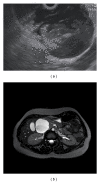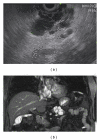Epidemiology, diagnosis, and management of cystic lesions of the pancreas
- PMID: 22007199
- PMCID: PMC3191780
- DOI: 10.1155/2012/147465
Epidemiology, diagnosis, and management of cystic lesions of the pancreas
Abstract
Although little is known on the true prevalence of pancreatic cysts, physicians are currently more frequently confronted with pancreatic cysts because of the increasing use of sophisticated cross-sectional abdominal imaging. Cystic lesions of the pancreas comprise of a heterogeneous group of diagnostic entities, some of which are benign such as inflammatory pseudocysts or serous cystadenomas and do not require resection when asymptomatic. Others like mucinous cysts or intraductal papillary mucinous neoplasms (IPMN) have a malignant potential and in these cases surgical resection is often indicated. For this reason an adequate distinction between the various cysts is crucial to optimize management strategy. Different diagnostic methods that could be of value in the differentiation include radiologic imaging techniques such as CT, MR, and endosonography. In addition, fluid aspiration for cytopathology, tumormarkers or molecular analysis is widely used. Different guidelines are available but so far no optimal diagnostic algorithm exists. We summarize the epidemiology, classification, clinical presentation, diagnostics, management, and future perspectives.
Figures




Similar articles
-
Cyst fluid analysis in the differential diagnosis of pancreatic cysts. A comparison of pseudocysts, serous cystadenomas, mucinous cystic neoplasms, and mucinous cystadenocarcinoma.Ann Surg. 1993 Jan;217(1):41-7. doi: 10.1097/00000658-199301000-00008. Ann Surg. 1993. PMID: 8424699 Free PMC article.
-
Overview of the clinical problem: facts and current issues of mucinous cystic neoplasms of the pancreas.Dig Liver Dis. 2008 Nov;40(11):837-46. doi: 10.1016/j.dld.2008.03.018. Epub 2008 May 22. Dig Liver Dis. 2008. PMID: 18499541 Review.
-
[Intraductal papillary mucinous neoplasia: which findings support observation?].Chirurg. 2012 Feb;83(2):123-9. doi: 10.1007/s00104-011-2183-8. Chirurg. 2012. PMID: 22271054 Review. German.
-
The role of endoscopic ultrasound in the management of intraductal papillary mucinous neoplasms.Minerva Med. 2014 Oct;105(5):413-21. Epub 2014 Jul 7. Minerva Med. 2014. PMID: 25000220 Review.
-
Cystic lesions of the pancreas: radiologic-endosonographic correlation.Radiographics. 2012 Nov-Dec;32(7):E283-301. doi: 10.1148/rg.327125019. Radiographics. 2012. PMID: 23150863
Cited by
-
Diagnosis and treatment of pancreatic pseudocysts and cystic tumors based on own material and quoted literature.J Ultrason. 2013 Sep;13(54):263-81. doi: 10.15557/JoU.2013.0028. Epub 2013 Sep 30. J Ultrason. 2013. PMID: 26673675 Free PMC article.
-
Endoscopic ultrasound-guided fine-needle aspiration for the diagnosis of pancreatic cysts by combined cytopathology and cystic content analysis.World J Gastrointest Endosc. 2015 Oct 25;7(15):1157-69. doi: 10.4253/wjge.v7.i15.1157. World J Gastrointest Endosc. 2015. PMID: 26504505 Free PMC article. Review.
-
Endosonography in the diagnosis and management of pancreatic cysts.World J Gastrointest Endosc. 2015 Mar 16;7(3):213-23. doi: 10.4253/wjge.v7.i3.213. World J Gastrointest Endosc. 2015. PMID: 25789091 Free PMC article. Review.
-
Intrapancreatic accessory spleen with an epidermoid cyst: a malignant mimicry.BMJ Case Rep. 2022 Feb 14;15(2):e247737. doi: 10.1136/bcr-2021-247737. BMJ Case Rep. 2022. PMID: 35165128 Free PMC article.
-
Pancreatic cystic lesions: The value of contrast-enhanced endoscopic ultrasound to influence the clinical pathway.Endosc Ultrasound. 2014 Apr;3(2):123-30. doi: 10.4103/2303-9027.131040. Endosc Ultrasound. 2014. PMID: 24955342 Free PMC article.
References
-
- de Jong K, Nio CY, Hermans JJ, et al. High prevalence of pancreatic cysts detected by screening magnetic resonance imaging examinations. Clinical Gastroenterology and Hepatology. 2010;8(9):806–811. - PubMed
-
- Lee KS, Sekhar A, Rofsky NM, Pedrosa I. Prevalence of incidental pancreatic cysts in the adult population on MR imaging. American Journal of Gastroenterology. 2010;105(9):2079–2084. - PubMed
-
- Zhang XM, Mitchell DG, Dohke M, Holland GA, Parker L. Pancreatic cysts: depiction on single-shot fast spin-echo MR images. Radiology. 2002;223(2):547–553. - PubMed
LinkOut - more resources
Full Text Sources

